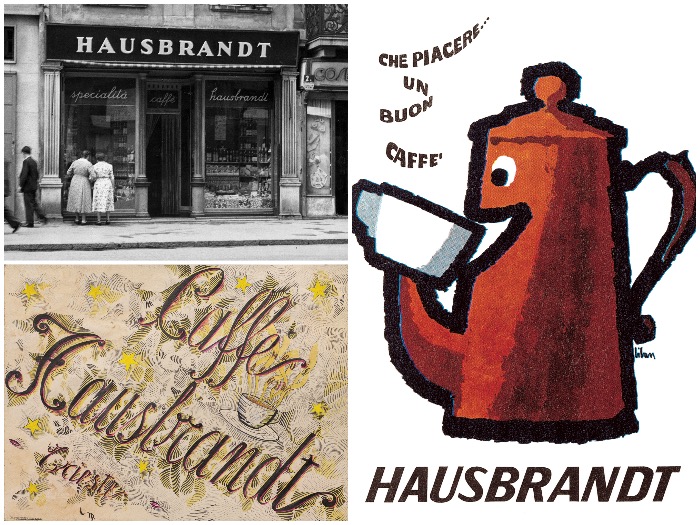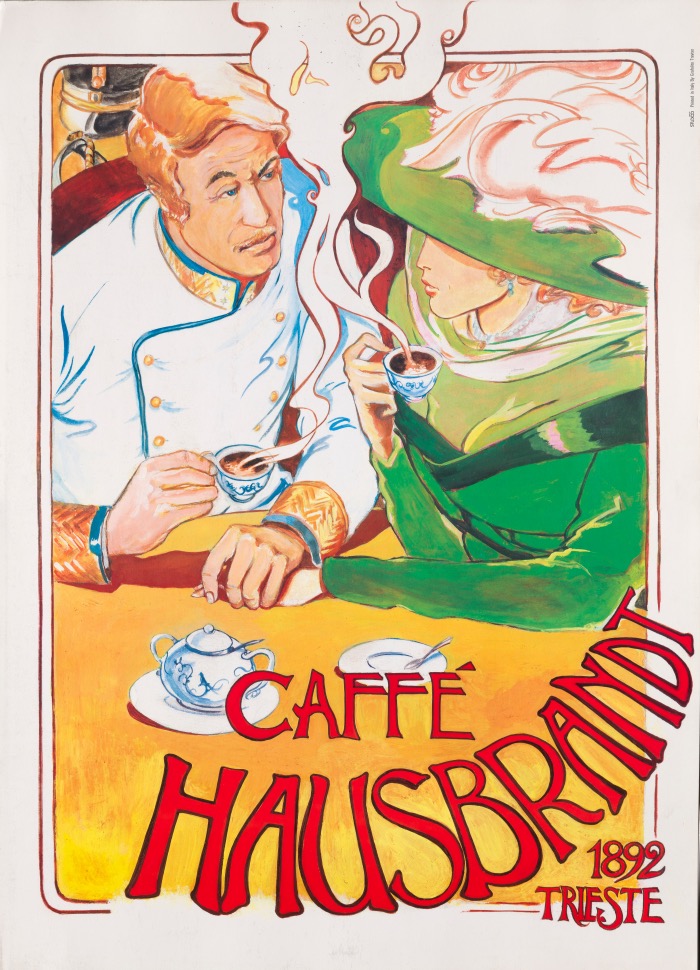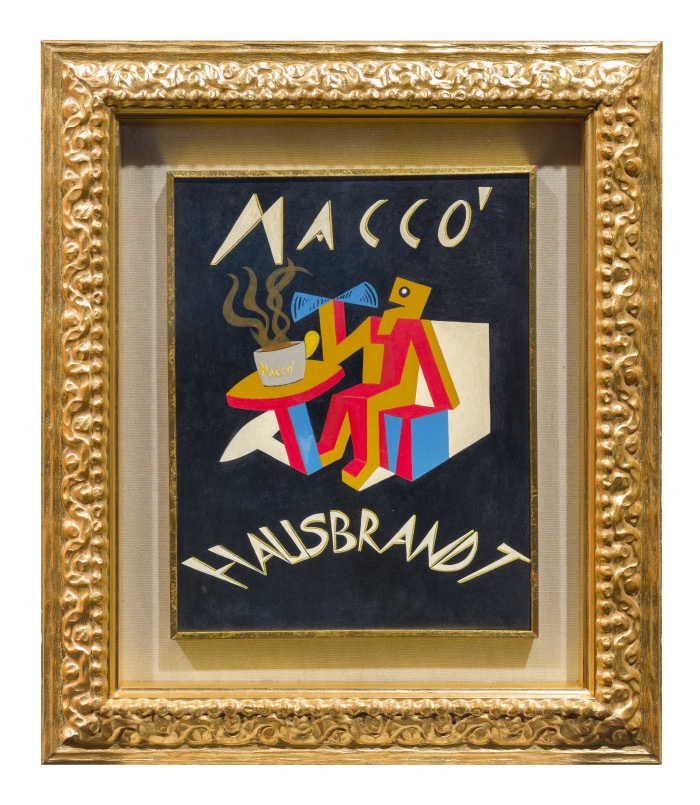
Caffeteria Hausbrandt – anni ’20 – Luciano Biban, logo Moka (1967) – Leopoldo Metlicovitz, grafica logo (anni ’20)
When does a brand become so iconic that it influences not only a market sector but even an entire city? In this post, I invite you to discover Hausbrandt, a brand that has spanned more than a century of history, shaping coffee culture with art and has strongly influenced Trieste’s artistic and cultural history.
Hausbrandt, art and coffee: a journey through Trieste’s culture

Locandina “Caffè Hausbrandt” – 1990
Founded in 1892, Hausbrandt is more than just a coffee brand. It is a true symbol, whose fascination has been intertwined with the evolution of Italy, adapting to the social and cultural changes of the time.
Thanks to 20th century advertising art and innovative marketing techniques, Hausbrandt has become an icon in the collective imagination.
THE ARTISTS BEHIND THE BRAND
Art and advertising have often walked hand in hand in the history of this brand. Figures such as the painter Leopoldo Metlicovitz, and advertising agencies such as Robilant and Demner Merlicek & Bergmann, have left an indelible imprint. These collaborations not only shaped the image of the brand, but also portrayed the Trieste of the era, bringing out various trends in taste and style.
Already in the years of the Bell’Epoque, Hausbrandt had used innovative advertisements such as the design of the Turk sipping coffee and raising three fingers to emphasise three words, “Hausbrandt Speciality Coffee”, an example of modern formal synthesis, symmetry and at the same time great iconicity in the orange turban; or like the famous 1910 campaign with the so-called “Old Men”, reminiscent of the images of the American Norman Rockewll and still one of the company’s most recognisable graphic signs.
Similarly, the slogan used was included in the packaging and on the company’s first vehicles, implementing a coordinated declination of the promotional campaign that was still unknown at the time.
However, it was in the years immediately following that the first Italian roasting company began to collaborate with some of the most important artists also involved in advertising graphics, including Metlicovitz from Trieste, who is considered one of the fathers of modern Italian poster art.
If you are interested in understanding how creativity and history can intertwine in unique ways, you may find it useful to read our page ‘5 THINGS TO KNOW ABOUT TRIESTE AND ITS HISTORY‘ for a broader cultural context.
Leopoldo Metlicovitz, in particular, a painter and illustrator born in Trieste in 1868, had become famous by collaborating with the music publishing house and Officine Grafiche Ricordi – his were the posters for Puccini’s “Tosca”, “Madama Butterfly” and “Turandot” – but also as a set and costume designer for La Scala Theatre, an illustrator of librettos, scores, calendars and magazines.
Metlicovitz created some of the first Hausbrandt advertisements, but also and above all a sign for Casa Hausbrandt in Trieste.
Luciano Biban, Venetian by birth and Friulian by adoption, who was born in 1935 and died at the age of just 33, on the other hand, gave life in 1967, by taking part in a competition, to the “humanized coccuma”, which will remain in the history of Italian communication and will become the symbol of the pleasure of Hausbrandt quality coffee.
To complete the logo, Biban – who was dedicated to advertising graphics, but also to painting, which had already earned him several prizes and awards – also inserted a payoff, placed where the coffee aroma is released, the first sensory characteristic of those who are about to drink it: ‘The pleasure of a good coffee’, Biban proposed, later changed to ‘What a pleasure… a good coffee’.
In 1980, it was Robilant Associati who evolved the iconic logo, anchoring the Moka to a rectangle that better defined it, making the sign more graphic and less pictorial, and inserting the colours – red and yellow – that have distinguished the Hausbrandt brand around the world. Then, twenty years later, in 2019, it was the Demner, Merlicek & Bergmann Agency of Vienna, founded in 1969, which undertook the restyling of the logo and product communication system.
The Moka becomes black and stylised, the look becomes more Central European, and the mood of the brand changes without distorting it. The basic elements remain the oblique cut lettering and the Moka, with the essentiality of a pure and minimal style.
Lastly, Martino Zanetti, who celebrated Hausbrandt’s 130th anniversary by personally intervening on the colourful and winking logo of its origins, in his revisitation of Roibilant. The animated ladybird, drinking a steaming coffee, herself comes out of a stylised cup cheerfully exclaiming “What a coffee!” to express the concepts of conviviality, sharing and joy that are the values of Hausbrandt.
For further information on the importance of art in the construction of Trieste’s identity, I invite you to visit the page The Sculptures of the Revoltella Museum in Trieste.
HAUSBRANDT INNOVATION, TECHNIQUE AND ART
But that is not all. Hausbrandt has always been at the forefront of coffee preservation and preparation technology. For example, it was the first company to package coffee in sealed metal containers, and it has always paid attention to the evolution of coffee machines, from the manual skills of the 1950s to today’s high technology.
The connection with Trieste, a city that symbolises cultural intersections, is one of the fundamental aspects of this history. At the time of Hausbrandt’s foundation, Trieste was already an important commercial hub for coffee, cementing a bond that persists to this day, also enriched by the activities of the Hausbrandt Foundation.
From the very beginning, Hausbrandt understood the importance of image and communication. Collaboration with leading artists has made the brand a point of reference not only in the coffee market, but also in the Italian artistic and cultural panorama. The link with Trieste, the city of Italo Svevo and Umberto Saba, is fundamental in the company’s history.
In 1748, the first café opened in Trieste: many others would follow in the 19th and early 20th centuries, still bearing witness in their furnishings, architecture and atmosphere to the fashions and styles of the different historical periods. However, it was above all their destiny as meeting places for artists, philosophers, politicians and intellectuals that made the cafés the fervent and vital heart of debates and crucial changes in society.
A year before Hausbrandt was born, the Industrialists’ Association was formed in Trieste and the Coffee Exchange was opened at the beginning of the 20th century.

Cartolina “Maccò”, in stile Depero, anni ’20
The story of Hausbrandt is a harmonious combination of innovation, art and culture. It not only offers us an excellent cup of coffee, but also a sip of Trieste’s cultural richness.
The next time you enjoy a cup of Hausbrandt, remember that you are not only tasting coffee, but also a piece of Italian history and art.

